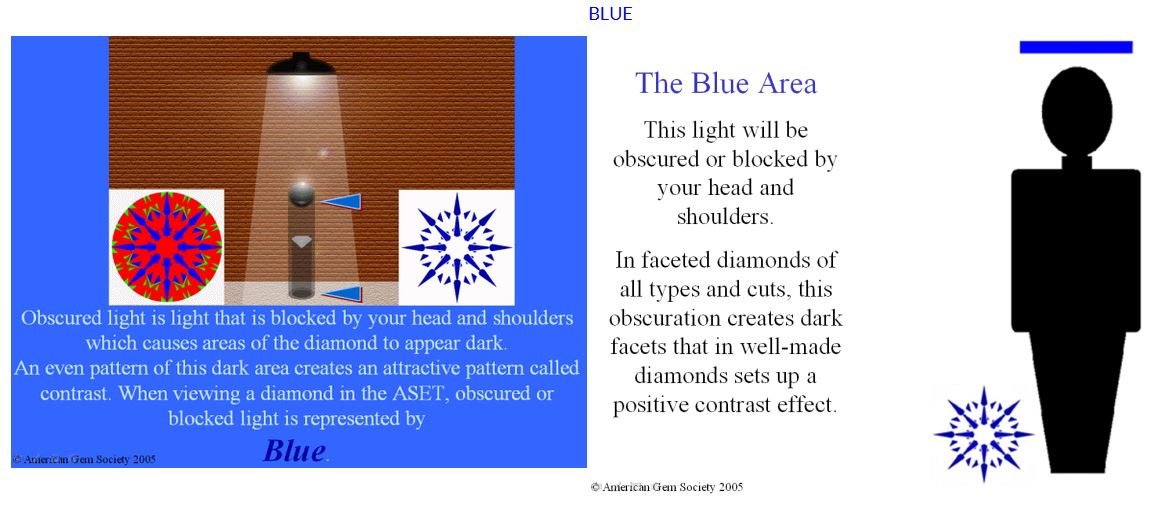RED REFLECTOR PICTURES
A Consumer's Guide to Understanding the Red Reflectors:
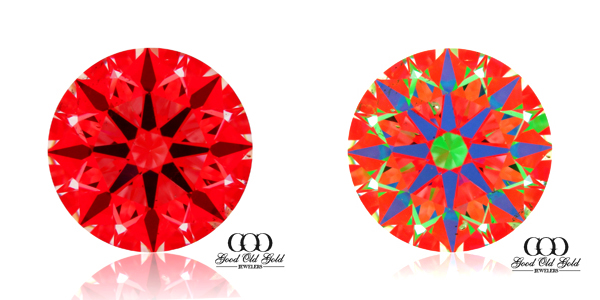
What am I looking at when I see these images?
Below is an in-depth understanding of these images or you could go through this quick guide powerpoint.
These red images are a test to see how much light return a diamond has and how much light leakage a diamond has. The tool used is a lightscope. There are a few various versions and that's why you see here two different types of images here. The first one which is called the lightscope or DiamXray has 3 colors, red, black, and white. The other which is called the ASET® has 4 different colors, red, green, blue, and white. In both images the red and white colors serve as the same function, red being light return, and white is light leakage. The blue and black colors both serve as contrast and the green in the ASET® serves as light return but less intense than the red color. These colors all serve a different purpose They show where the light is drawing from. All the facets of a diamond will function in either one of two roles. Mirrors or windows. It is primarily the combination of both pavilion and crown angles that will determine whether the facets will function in either role but generally speaking the crown facets primarily function as receptors of light, allowing that light to pass through within the diamond and it is the pavilion facets that should function in the primary role as the mirrors reflecting light out through the crown into the face of the observer. The path of light traveling and bending through a diamond is called light refraction. Let's follow a beam of light as it travels throughout a diamond. This is made possible with ray tracing software developed by Moscow State University and is a very sophisticated application for tracking and observing light behavior in diamonds with any given set of proportions, either through a scan and model created in another application (like Sarin, Helium or OGI) or you can input the parameters manually. So just to recap.
Red: Light Return
Black or Blue: Contrast
Green: Light Return (But Less intense than the Reds)
White: Light Leakage
This sample stone is one that is cut to *super ideal* specs. 34.5? crown angles, 40.8? pavilion angles and a 57% table.
1. The initial ray is entering the table facet at 100% intensity.
2. 17% is reflecting off the surface of the diamond. This external reflection is often referred to as luster or glare.
3. The remaining 83% is refracted within the diamond bouncing off 2 pavilion facets and a crown bezel facet before exiting.
4. Before leaving the crown 19% of that ray bounces within the diamond again and peters out before exiting (shown in sky blue).
6. 100%, less 17% (external luster/glare), less 19% stray refraction, leaves 64% exiting through the crown as dispersion/brilliance.
In short, of 100% light that enters the diamond 81% is reflected and refracted off the facets and back into the eyes of the viewer. For diamonds, THAT'S EFFECTIVE considering its only 1 single beam amongst many that occur simultaneously.
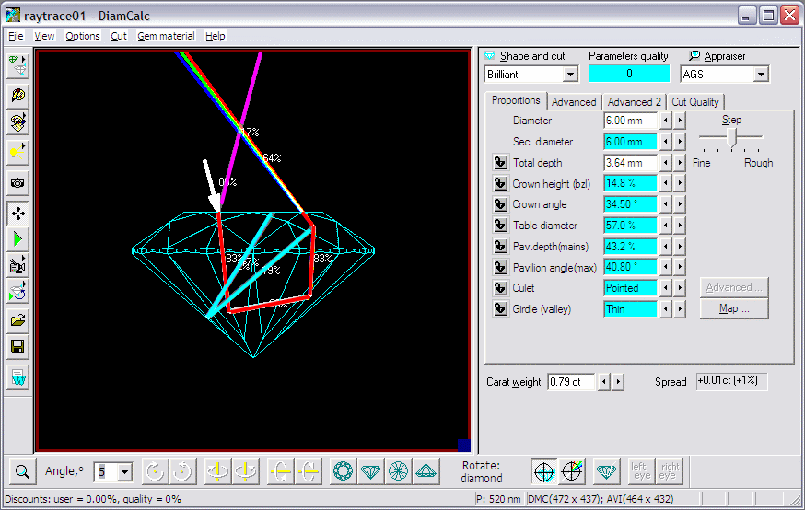
In the below image look what happens when we alter the crown/pavilion angles to non ideal standards. The only light exiting the crown now is the glare at 17%. All brilliance/dispersion is lost out through the bottom. NOT GOOD.
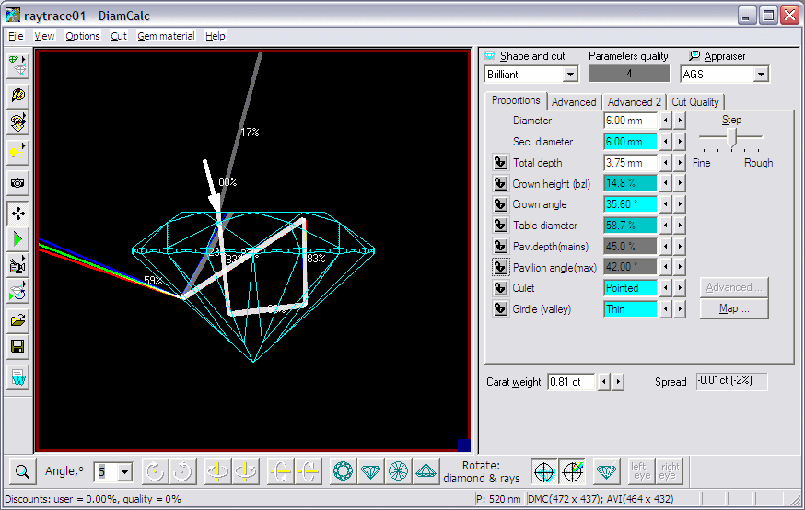
These ray trace examples show us how the facets of a diamond can function as mirrors and/or windows in a very scientific manner. Reflector technology works along the same idea but shows us graphically which facets are functioning in their respective roles without any given numerical breakdown.
- Mirrors & Windows
Observing and Interpreting the Colors: Red Reflectors
One basic function then that all red reflectors show us is what role the facets are functioning as (ie, mirrors or windows). If the facets are functioning as mirrors we will be able to observe predominantly all reds and blacks as we look through a FireScope, SymmetriScope, DiamXray or IdealScope. Here are a few examples of various diamonds we sell showing excellent light return to poor light return with the Diamxray accommodating their respected Aset® underneath. The first 2 diamond qualities (Ascendancy & Platinum) are our biggest selling diamonds. We'll decipher the information from these images in more detail below. Before we do however some basic explanations are in order.
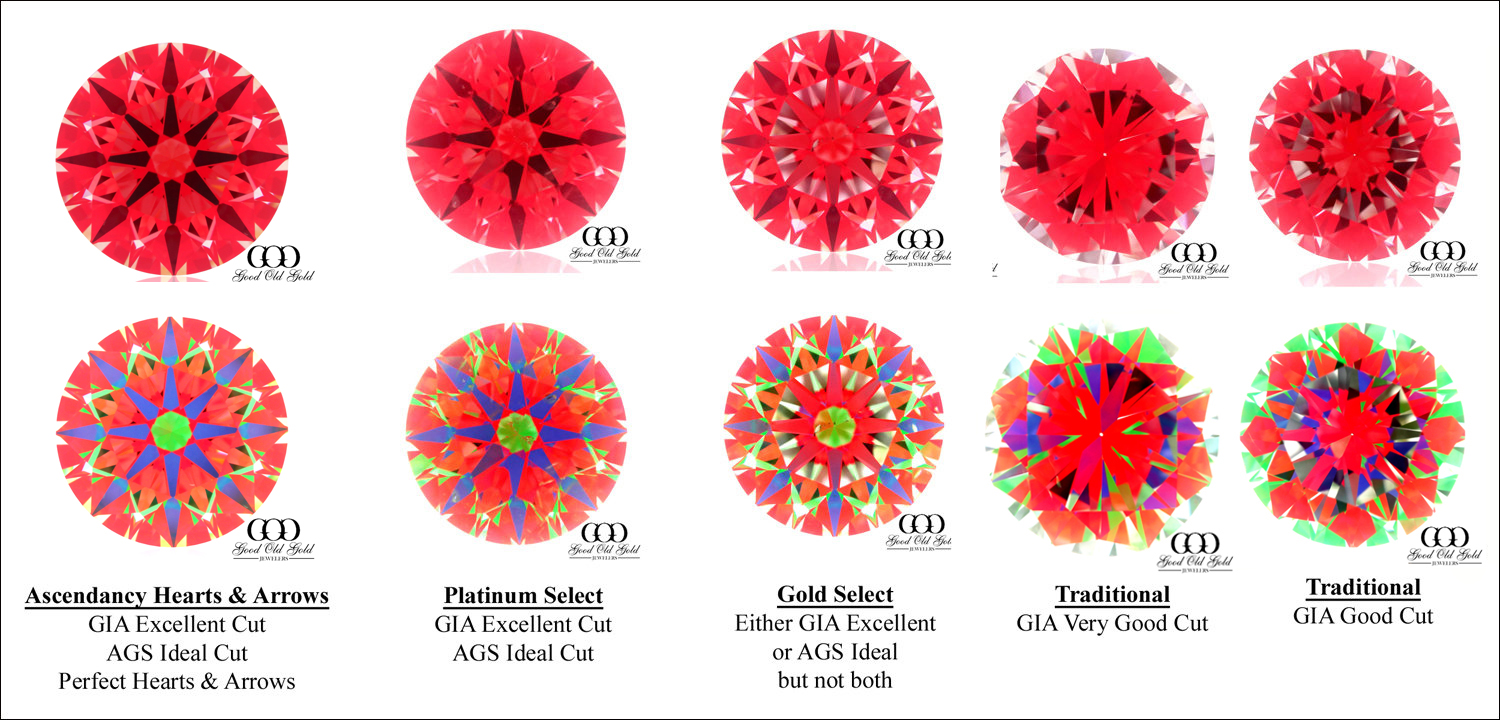
When a diamond is viewed by a person in a normal viewing environment there should be 2 different phenomena that should be observed.
A. Facets that are reflecting back light.
B. Facets that will reflect back the reflections of things in the atmosphere such as the person's reflection within the stone that is blocking or obstructing light.
Hence this DiamXray image translates into an appearance in bright hemisphere lighting akin to the photograph next to it.
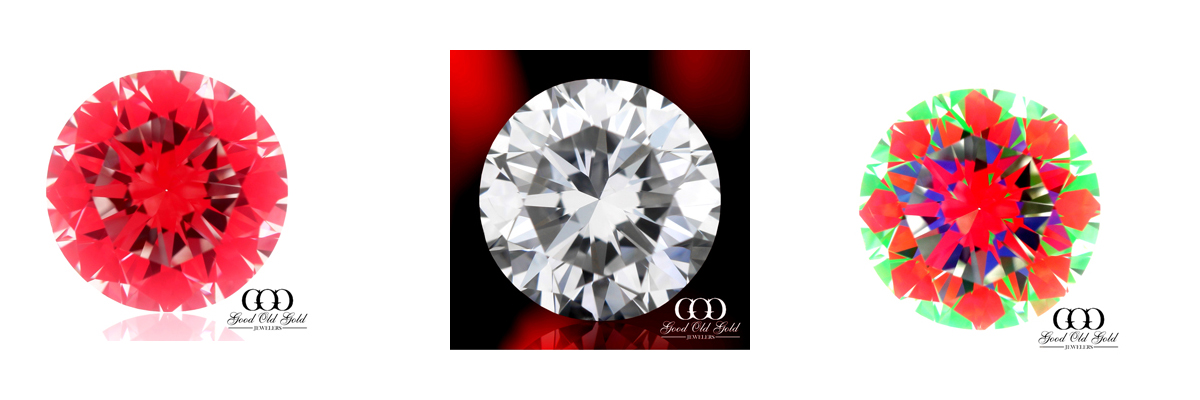
Note that the bright areas within the diamond's photograph appear as reds in the DiamXray image and the blacks appear as darker areas.
This obstruction is also referred to as obscuration and accounts for what we could also call "head/body shadow". The graphic below demonstrates this as the reflection entering the stone between the black arrows are a reflection of Sarah's head & body. Red would be atmospheric light entering at all other angles.
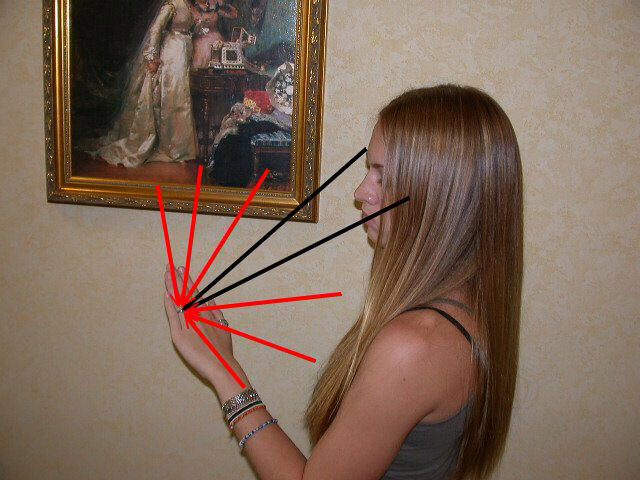
The amount of obscuration then depends upon the size of the viewers head or how big the object is in front of the diamond that would obstruct light from entering. Most gemologists agree that 25-30 degrees of obscuration accurately accounts for most head sizes and a good standard upon which to base this obstruction on.
The Ideal-Scope accounts for 25 degrees of obscuration. DiamXray & FireScope, 27 degrees. The new AGS ASET, 30 degrees (although algorithm's for 30 and 40 degrees will be considered in AGS' final grade as well as tilt factors). This observance of light and dark is what causes contrast patterns within the diamond and is a major contributing factor to the brightness or brilliance of the stone (as discussed in our chapter on brightness).
Going back to an example image lets examine the details of the image and how it translates to human eye observation. A GIA Very Good on the left with an Ascendancy on the right.
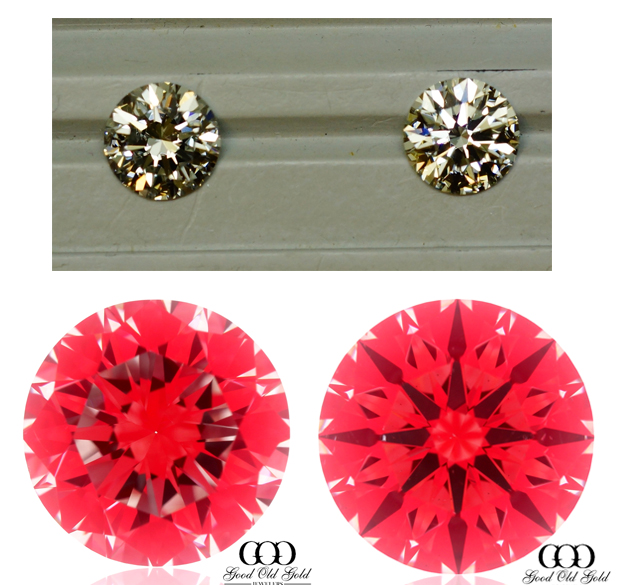
As observed in this image you can see four primary colors. Here are the colors and their interpretation.
1. BLACKS = light, or more accurately obstruction entering and exiting at high angles. As pointed out above, this represents obscuration (head shadow) however when the diamond is rocked and tilted in normal fashion these blacks become some of the most intense reflectors of light giving off strong fire and scintillation in direct light conditions (not hemisphere). In diffuse light conditions are points of contrast contributing to brightness and what would be called dynamic scintillation.
2. DARK REDS = light being returned to the viewers eyes at the strongest intensity (face up view).
3. LIGHT REDS = light being returned to the viewers eyes at a weaker intensity. The paleness of the reds indicates the weakness at which the light is being returned to the viewer and generally only observed in direct or strong lighting conditions. (note: The contrast between light and dark reds is a feature best seen in DiamXray photography. Other reflectors do not show this contrast but generally show all reds at the same saturation).
4. WHITE = blatant leakage. Whites indicate facets that are functioning as windows as opposed to mirrors and contribute to leakage contrast as observed around edges (perimeter) of the diamond.
What is desired is a nice balance of blacks and reds with as little white as possible. The above image represents what is perhaps the loosest standards
AGS will accept in their new cut grading system and that is good.Here is a comparison of a diamond exhibiting good light return with good contrast next to a stone that's well ... a pooper. :) The stone on the right is exhibiting too much light leakage contributing to less brilliance and the lack of blacks indicate weak fire, contrast & scintillation. The actual photographs are taken in hemisphere lighting and accentuate the differences in appearance as seen between the two.
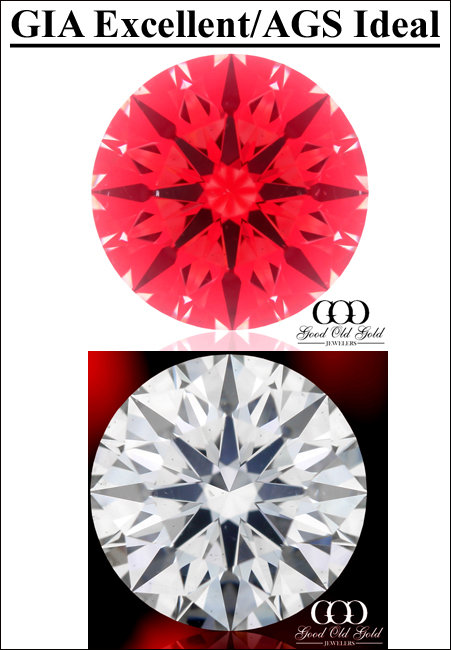
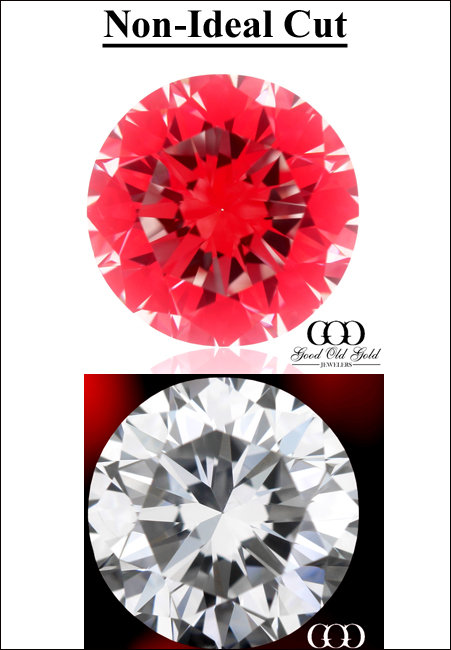
- Optical Symmetry
Optical symmetry refers to the alignment of the facets on a 3-dimensional plane and demonstrates the precision to which the diamond has been cut optically. In order to do this, a cutter must be familiar with what proportions and symmetry produce the finest light transmission and appearance. While optical symmetry can be viewed in a Hearts & Arrows viewer we can also observe this phenomenon quite easily through reflector technology as well.
Here is an example of two ideal cuts. The diamond on the right not only has superior light return but introduces the metric of optical symmetry to the equation. The diamond exhibiting the superior optical symmetry is more finely crafted, takes approximately 4x the amount of time to cut and results in what is perhaps one of the most precision cut diamonds with incredible optics while the stone on the left was probably cut in roughly 1 hour or so.
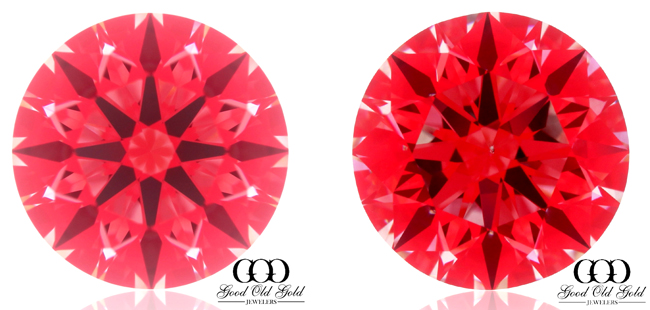
Unfortunately no metric for optical symmetry is taken into account in the new cut grading systems and we personally feel this is a disservice to those factories who are taking their time to cut precision diamonds. As noted earlier this optical symmetry can also be viewed through a Hearts & Arrows viewer. Below is a photograph of this same diamond through a Hearts & Arrows viewer. The arrows are obviously what is seen in the face-up shot, while the Hearts are observed in the face down (upside-down) position. Reflectors are good devices for displaying this component of optical symmetry. Here is a photograph of a diamond with superior optical symmetry next to a standard ideal in hemisphere lighting..
In GIA's observation testing a fairly equal amount of people found the 2 to be equally as beautiful which is primarily why no metric for optical symmetry was included.
- The optical results of both Slope & Azimuth Angles
Of all the reflectors in use there is one in which we can actually photograph the optical effects of both "slope" & "azimuth angles" and how far they deviate from "ideal" which can be observed in the face-up position.
- Slope Angles
For clarification, there are actually 2 angles that each facet is cut to. One would be considered the slope angle, the other being the azimuth angle. When you read the results of an AGS Report or a Sarin/OGI Report you are strictly seeing slope angles.
| AGS Report showing average slope angles (34.1? crown angle/41.2? pavilion angle) | Sarin showing average slope angles (crown 34.4/pavilion 40.8 degrees) |
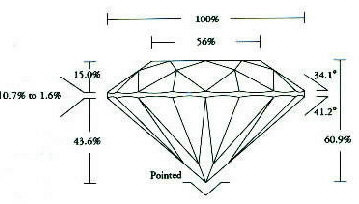 | 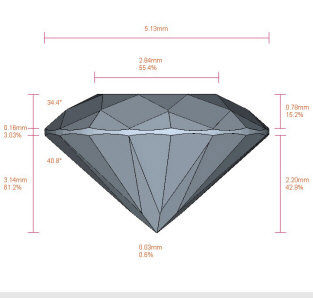 |
Here is a graphic from a Helium Report showing every slope angle on every facet. (Minimum angle is colored in red, maximum is colored in green for each facet set).
To be clear, slope angles are measured in the north/south orientation. Steeper/deeper combinations of slope angles result in more light leakage.
| Ideal Slope Angles coupled with ideal optical symmetry | Steep/Deep angles coupled with chaotic optical symmetry |
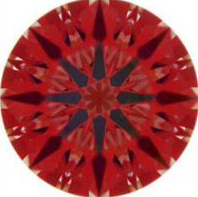 | 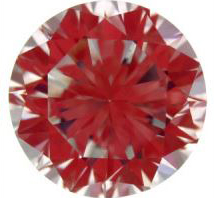 |
Azimuth angles are not measured in the north/south orientation but in the east/west orientation. It is easier to think about these angles in relation to an airplanes pitch and roll. When a pilot is flying an aircraft and pulls back on the stick he is altering the pitch or the angle at which he is ascending or declining into the sky. This would be akin to slope angle.
When a pilot pulls the stick to the left or right (east/west orientation) he rolls the plane in the corresponding direction. This is akin to azimuth angles and is a phenomenon we can observe and photograph in DiamXray technology in the minutest detail. This is one primary feature that separates this reflector from the rest that are covered in this study.
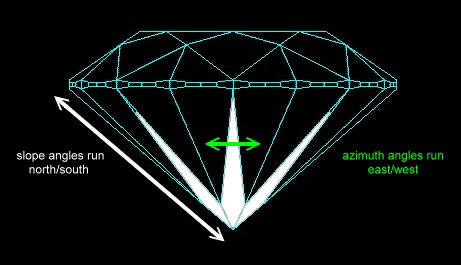
When a diamond is cut to ideal proportions (akin to the stone on the left above) and has little deviation in azimuth angles those are the optics that result (see below example as well). Rich dark reds throughout the stone coupled with the highest contrast. Here is a graphic of a diamond with ideal slope angles and very little deviation in azimuth angles from ideal. This is as perfect and precise as Hearts & Arrows come.
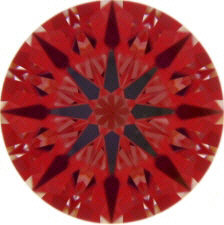
Here is a graphic from a Helium Report demonstrating how far the azimuth angles on this diamond deviate from ideal.
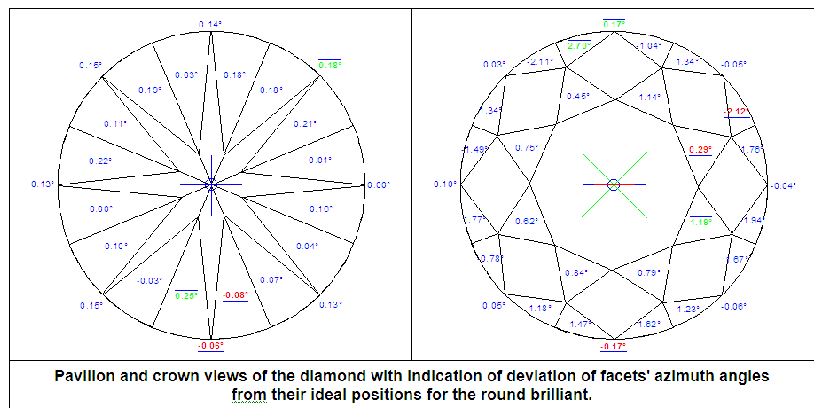
Note on the pavilion main facets (shown on the outside of the circle) the minimum and maximum deviation from ideal is a -.06? (shown in red) to +.18 degrees (shown in green). Looking at the rest of the pavilion facets (the lower halves or lower girdles) we see once again extremely tight variances and hardly any deviation from ideal. The lower halves show a minimum deviation at -.08? with maximum deviation at .25? Again ... extreme precision. This minute deviation from ideal demonstrates unprecedented precision in cutting which is confirmed by the optical results shown through DiamXray technology. While we are focusing on pavilion reflections through the crown it doesn't hurt to note the awesome precision in the crown bezel facets as well.
Now that we know what the rarest looks like let's examine another diamond. Before we look at the DiamXray image let's take a look at how far the azimuth angles deviate from ideal.
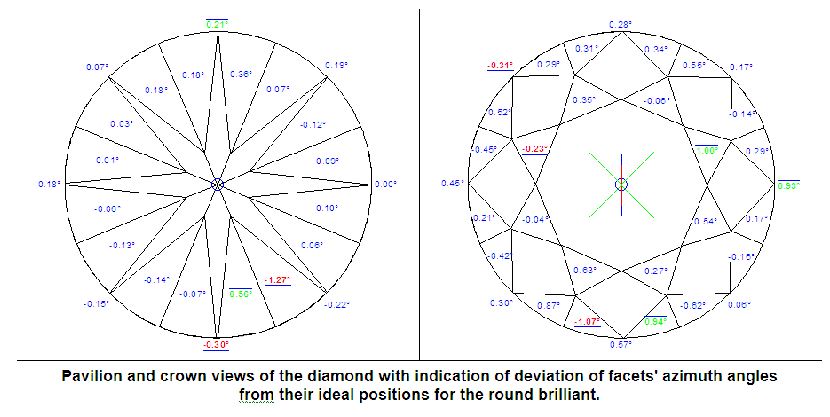
Ok... examining the azimuth angles deviation from ideal on this stone take note that the pavilion mains do not deviate no greater than .5 degrees either way. Minimum deviation on the pavilion mains is -.30? from ideal (red), maximum deviation from ideal is .21? (green). Ultra tight. When we examine the deviation from ideal on the lower halves (also called lower girdles) take note of the two lower half facets in the 5-5:30 position. One deviates from ideal a full -1.27? while its adjoining lower half deviates at +.56? and is just fine. The remaining lower halves are all tight. The result of twisting a lower half in the east/west orientation will alter the path of light as it exits the crown. As you examine the DiamXray image below take a wild stab at which lower half has the deviation of -1.27??
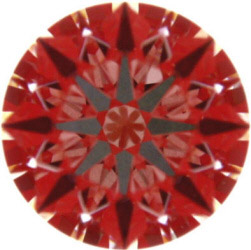
If you guessed the lower half facet around the 1:00 position you picked right as that is the most obvious area off the pavilion that is leaking light.
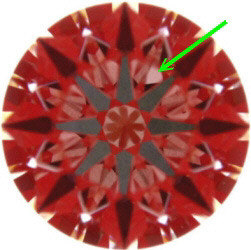
Here's the comparison of a diamond with one of the rarest optical signatures that can be attained next to the near perfect one above. It should be pointed out that the minute differences observed between these 2 diamonds under DiamXray technology are not discernible to the human eyes, even in direct lighting conditions which enhance intensity. Both are beautiful stones and both easily qualify as GIA/AGS ideals. With the sharp similarities in slope angles between the 2 diamonds the primary difference is in the azimuth angles between these 2 diamonds.
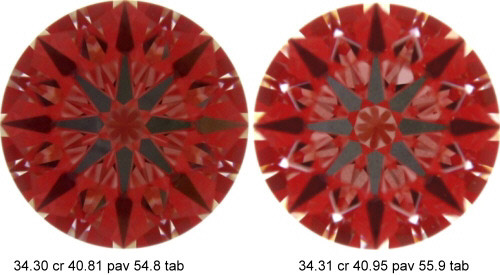
While a shift/twist in azimuth angles can alter the optical signature of a diamond (as pointed out in the demonstration above) it should also be pointed out that there are many factors that can alter the optical signature, each of which can be photographed exclusively through DiamXray technology. Other factors which can alter an ideal optical signature are symmetry faults, such as facet alignment, the diamond being out of round, etc. These extra details we can photograph and demonstrate through DiamXray shows us rather plainly another metric regarding to the optical properties of a diamond, namely that of Intensity. The darker the reds are, the more intense light is reflecting out from within the diamond. The paler or lighter the reds are, the weaker the light is reflecting out of the diamond off of those facets.
Here is a photograph of a diamond taken under one of the basic reflectors (in this instance Ideal-Scope) and the same identical diamond under DiamXray.
| Ideal-Scope Photo | DiamXray Photo |
| All reds appear at same saturation leading the observer to believe all light is exiting at same intensity. | DiamXray technology plainly shows the contrast between facets reflecting back light at higher intensity vs. lower intensity. |
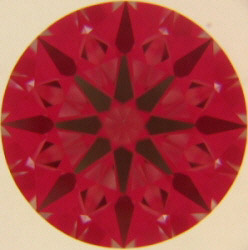 | 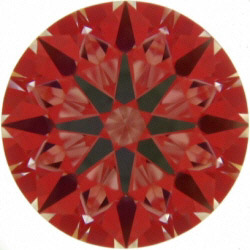 |
This, by no means renders Ideal-Scope images as useless but it is important to understand the differences observed in each of these reflectors as one image (the Ideal-Scope) actually makes the diamond appear that all light is exiting at the same intensity when this isn't the case and can be seen via DiamXray. This is what separates the DiamXray reflector from the others on the market and is why it is our scope of choice. This technology, as of this publishing is exclusive to our own lab. It is important to point out that the metric of intensity will generally only be observed in direct/spotlighting environments that enhance fire and scintillation as observed in those environments. In just about all daylight conditions the metric of intensity plays a less prominent role so as long as the facets are functioning as reflectors and not leakers. The stone will be as bright as another diamond even if it does not have the same intensity as photographed under DiamXray.
In summary, regarding red reflectors we have learned ...
- All red reflectors show us whether facets are functioning as either mirrors or windows (reflectors vs non-reflectors).
- Red reflectors also show the gemologist/layman the level of craftsmanship to which a diamond has been cut by observing it's optical signature pattern. Superior craftsmanship will display itself by observing the 8 rayed star, as spokes in a wheel. Diamonds whose craftsmanship is not as good will display as a chaotic pattern.
- DiamXray not only shows the details above but also shows a sharp contrast between dark and pale reds demonstrating the level of intensity as it exits a diamonds crown. It is the only reflector designed for the purpose of both viewing and photography.
AGS' Angular Spectrum Evaluation Tool (ASET): Where is the Light coming from?
What DiamXray is to light output, ASET is to light input and the results we see under it can impact diamond appearance not only in your strong/direct lighting environments but even more so in other more common environments such as most day lighting.
The basic construction of the ASET makes certain assumptions regarding the viewing of diamonds which in most instances are true but in some are not. Those assumptions are ...
That the diamond is below the observer. Ie. The observer is holding the diamond in the face up position and looking down upon the stone. Not eye level and not above.
That the brightest light sources are coming from above (45?-75?) off the horizon. In most circumstances this also is true. One exception (among others) would be if you were outside during a sunset. Then your brightest light source is coming from the hemisphere (approx. 0?-45? zone).
Being familiar with these basic assumptions let's take a closer look at this tool and how it examines light performance.
The graphic to the right displays the various colors which the ASET shows us.
- Green = Light entering from the horizon which in most cases is light reflected off of walls as opposed to direct light sources from above. In most circumstances these are the weakest sources of light input. Therefore minimal greens are a desirable feature to see in an ASET image.
Red = Light entering from high angles. In everyday real world environments whether we're outside in daylight or inside a building under office (fluorescent) or spot (halogen or LED) lighting, the brightest sources of light come from these angles. A highly desirable color to see in ASET images.- Blue = Blue is representative of things obstructing light, which in the case of ASET represents the shadow of the individual who is examining the diamond and blocking light. A balanced distribution of blues is vital to providing the necessary contrast that contributes to the best brightness. If you have too much blue clumped into one area of a diamond that would be poor distributions of contrast.
The following graphics are used with permission from AGS' presentation on the ASET which best explain the ASET's principal and use.
GREEN
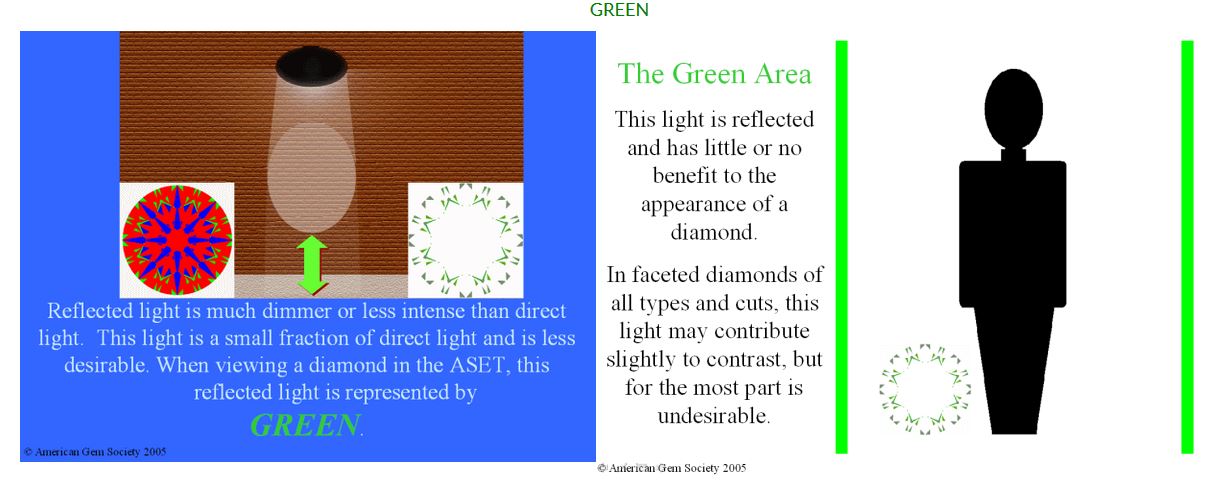
RED
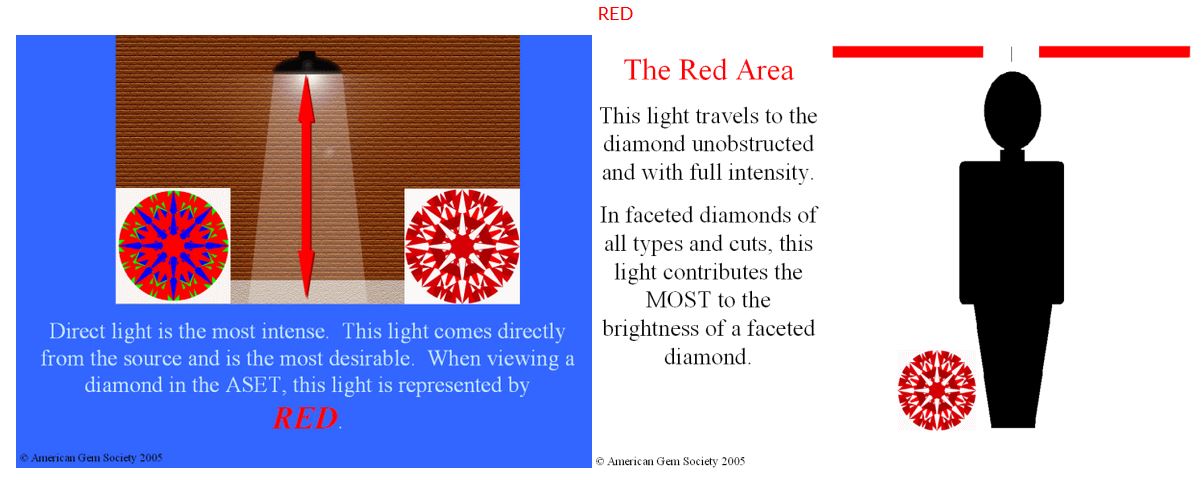
BLUE
